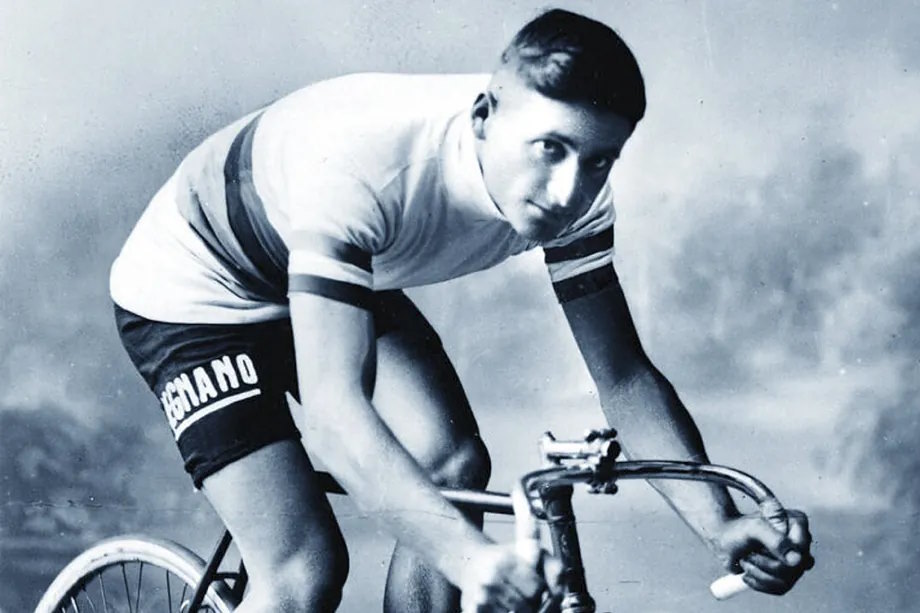The first capo of the Giro d'Italia started earning a living by playing the trumpet in the band of Cittiglio, his hometown near Varese. Two of his brothers were also musicians: Albini, a trombonist, and Benito, a saxophonist. Alfredo Binda (August 11, 1902) grew up in a family where there was not much on the table. He was the tenth of 14 siblings, the son of a builder who moved to Nice after World War I. In his home, everyone had to pitch in, and from a young age, he worked as an apprentice plasterer, but what he really enjoyed was riding a bike. Before turning 19, he won his first race, marking the beginning of the extraordinary centennial story of an incomparable pioneer.
Binda, after winning 500 lire as the best climber in the Ghisallo climb in 1922, decided to pursue cycling. In 1924, he went to Milan to participate in the Giro di Lombardia, finished fourth, and then signed a contract with the Legnano team. The tifosi called him Il Trombettiere di Cittiglio (The Trumpeter of Cittiglio). He surprised everyone with his strength, speed, and climbing skills. In 1925, a century ago, he made his debut in the Giro d'Italia. At that time, the local idol was Costante Girardengo (29 years old), the winner in 1919 and 1923, supported by Benito Mussolini. The cyclist from the fascist regime entered that Giro as the main favorite. The race started on May 16, with a stage from Milan to Turin covering 278 kilometers and lasting nearly 10 hours. In the early 20th century, cyclists raced one day and rested the next.
On the second day, with the finish in Arenzano, Girardengo took the lead, a privileged position he held until the fifth stage when the newcomer Binda, at 22 years old, took over the race lead by taking advantage of a flat tire and the betrayal of Gaetano Belloni (who did not wait for his teammate and helped Binda in exchange for a stage victory). The leader fell more than five and a half minutes behind. In Naples, the first significant intergenerational surpasso in the history of cycling occurred. Binda, who won the next stage with the finish in Bari, covering a hilly route in 13 hours and three minutes, did not relinquish the top spot on the podium until the end of the race on June 7 in Milan. Until that date, he withstood the attacks of his rivals and the toughness of marathon stages, like the ninth one, from Sulmona to Arezzo, covering 377 kilometers, won by Girandengo, taking 15 hours, 33 minutes, and 55 seconds. Mussolini's rider finished second, four minutes and 58 seconds behind Binda. Girandengo won six of the 12 stages but never finished a Giro again.
The new idol captivated with his elegance on the bike. The magic of La Gioconda. Now, 100 years have passed since the first great duel in the Giro between a champion in decline and an emerging young talent. A challenge that repeats in this edition between PrimozRoglic and Juan Ayuso (also 22 years old).
Binda was a novice with a background. During his time as a rider in France, he showed interest in mechanics, equipping his bikes with thick tubular tires. Chronicles from that time tell that he completed the 3,520 kilometers of the 1925 Giro without a flat tire. A very reliable cyclist who the following year could not repeat victory due to a fall, finishing second. In 1927, he returned with a general classification win and triumph in 12 out of the 15 stages. That year, he also became the winner of the first World Championship in history. He also dominated the Giros of 1928 and 1929. His overwhelming dominance and distant character ("I have no interest in putting on a show. My business is to win races," he said) led to a distancing from the public, who favored Learco Guerra, Giardengo's heir, also backed by the National Fascist Party.
Binda's superiority bored fans and was not profitable for advertisers. In 1930, the Gazzeta dello Sport paid him not to race in the Giro. The race organizer paid him 22,500 lire, an amount equivalent to what he would have received for winning the general classification and several stages. That year, Binda participated in the Tour, where he achieved two stage wins. He returned to the Giro in 1931 but had to retire due to a fall. In 1932, he finished seventh, and in 1933, he secured his fifth title. In the Corsa Rosa, he won 41 stages, a record that stood until 2003, surpassed by Mario Cipollini.
Binda retired in 1936 after fracturing his femur in the Milan-San Remo classic. In addition to his five Giros, he won three World Championships, two Milan-San Remo races, and four Giro di Lombardia races. He served as the national team coach for 12 years. He passed away at the age of 84 on July 19, 1986, in his hometown of Cittiglio.
